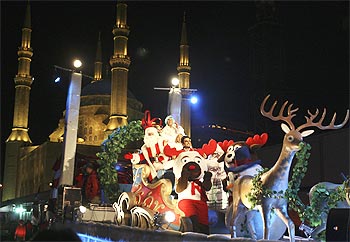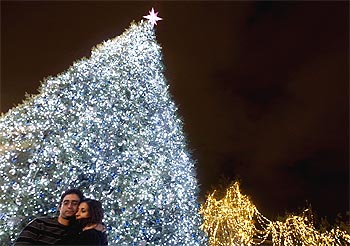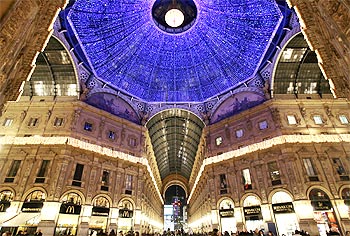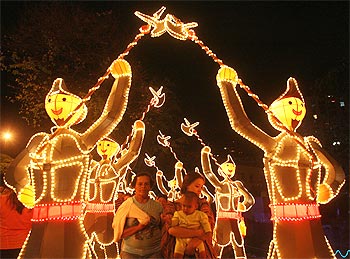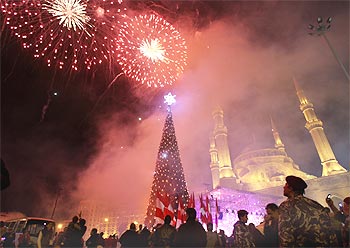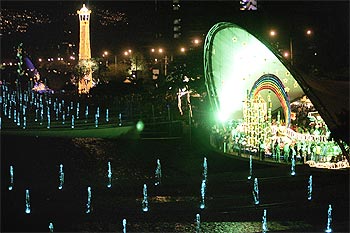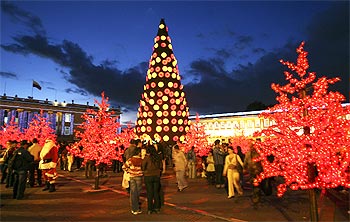 | « Back to article | Print this article |
Christmas spirit warms up hearts
Lots of fun and frolic, a dash of history and piety, fluffy cakes, fine wine and tons of festivities. That in a nutshell is Christmas.
For millions, the festival is a time to get together with their families and strengthen bonds of love and affection. Kids are on their best behaviour to get into the good books of Santa Claus.
Glittering stars, melodious carols, crisply wrapped gifts, twinkling lights, hot cocoa, gingerbread cookies and midnight mass, Christmas is each one of them and all of them.
Christmas spirit warms up hearts
Christmas is about the celebration of the birth of Jesus, who spread the message of love and service to humanity. Rediff.com captures the laughter, fun and the Yuletide spirit across the world.
The Christmas story may have many versions, but the spirit of the festival is common to all.
December 25 is generally considered to be the birth date of Jesus Christ. The Bible does not mention Christmas, and early Christians did not observe the birthday of Christ. Christmas, as we know it, became widely popular only in the 19th century.Christmas spirit warms up hearts
In ancient pagan times, the last day of winter in the Northern Hemisphere was celebrated as the night Great Mother Goddess gave birth to the baby Sun God. It is also called Yule. On that day a huge bonfire is lit around which everyone would dance and sing to awaken the sun from its long winter sleep.
In Roman times, the celebrations came to honour Saturnus (the harvest god) and Mithras (God of light).
The word Christmas means 'Mass of Christ', later shortened to 'Christ-Mass'. The even shorter form 'Xmas' -- first used in Europe in the 1500s -- is derived from the Greek alphabet, in which X is the first letter of Christ's name -- Xristos.Christmas spirit warms up hearts
The exact day of Christ's birth is a matter of debate. The story goes that in Nazareth, Israel, lived Joseph and Mary. Mary told Joseph of a dream one day in which an angel told her that she had been chosen to bear the Son of God.
As the couple reached Bethlehem, they could not find an inn. They took refuge in the nearby caves, as Mary was close to delivering the baby. Joseph cleaned one of the stable rooms and next day Mary gave birth to a son who was named Jesus, as told by the angel in her dreams.
The legend goes that when the baby was born a great star appeared over Bethlehem that could be seen for miles.
Christmas spirit warms up hearts
The shepherds in the nearby fields saw an angel who said, 'Fear not. For I bring you tidings of great joy. For unto you is born this day in Bethlehem, a saviour who is Christ, the Lord.'
'And this shall be a sign unto you. You shall find the baby wrapped in swaddling clothes and lying in a manger,' said the angel.
Traditionally Christmas starts on December 25 and ends 12 days later on January 6 with the Feast of Epiphany, also called 'The Adoration of the Magi' or 'The Manifestation of God'.
Christmas spirit warms up hearts
A beautifully decorated evergreen tree with coloured lights has become one of the most beloved symbols of Christmas.
The tradition of a festival tree has been around since ancient times and has played an important part in winter celebrations for many centuries.
An evergreen tree was considered a reminder of the fact that the darkness and cold of winter would end and the green of spring would return.
Christmas spirit warms up hearts
Christmas carols express the truths of the life in a musical way. 'Peace on earth and mercy mild, god and sinner reconciled'. It is a way of expressing the momentous event of Christ's birth.
Some of the famous carols sung during Christmas are O Tannenbaum, O Tannenbaum, O Christmas Tree, O Christmas Tree, Rudolf the Red-nose Reindeer, Jingle Bells and We wish you merry Christmas.
On the night before Christmas, all across the world, millions of children are tucked in their beds with visions of Santa Claus visiting them.
Christmas spirit warms up hearts
Santa Claus has become the most beloved of Christmas symbols. The image of the jolly old elf flying in a sleigh pulled by reindeers and leaving toys and gifts for every child is known worldwide.
Many stories and legends have been told of St Nicholas, popularly known as Santa Claus. These make us understand his extraordinary character and why he is so beloved and revered as protector and helper of those in need.
Children all over the world continue the tradition of hanging Christmas stockings and wait for the Santa to fill their stockings with goodies.
Christmas spirit warms up hearts
The spirit of Christmas has been aptly summed by the author of Pickwick Papers and Tale of Two Cities, Charles Dickens.
Writing in the Pictorial Times in December 23 1843 he says: 'At this joyous season of dinners and laughing faces, it becomes all who are worthy to enjoy such mirth to the full, to think of the poor who, without our aid, can have no enjoyment...
While the fire blazes on our hearth, and the table is covered so plenteously, let us think of the poor in their chilly hovels with bare tables, and of the yet more wretched objects, houseless wanderers in the open streets...'
